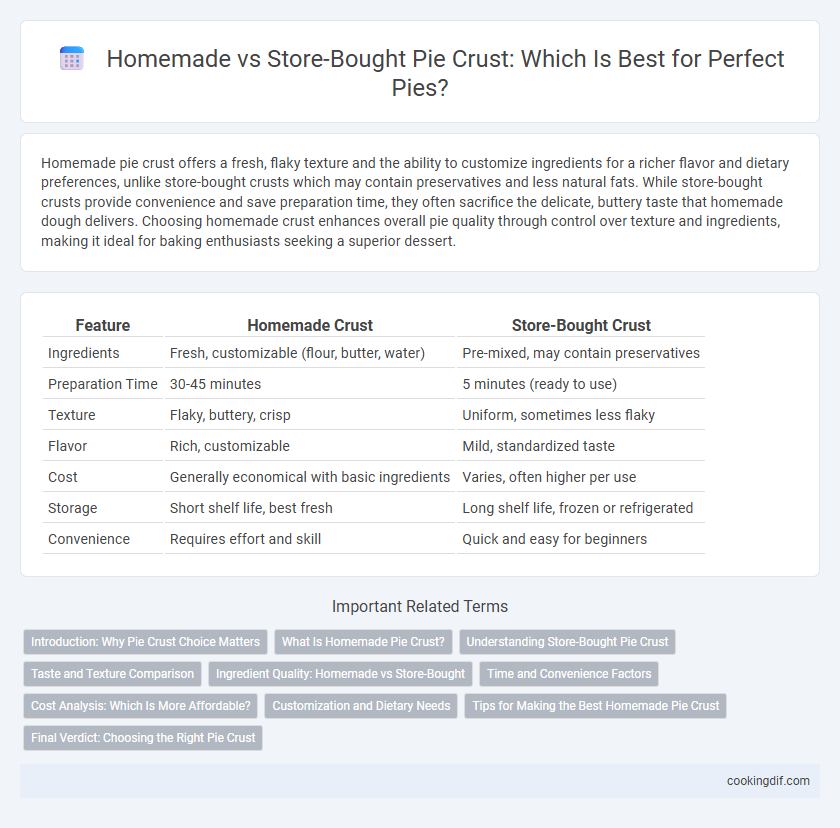Homemade pie crust offers a fresh, flaky texture and the ability to customize ingredients for a richer flavor and dietary preferences, unlike store-bought crusts which may contain preservatives and less natural fats. While store-bought crusts provide convenience and save preparation time, they often sacrifice the delicate, buttery taste that homemade dough delivers. Choosing homemade crust enhances overall pie quality through control over texture and ingredients, making it ideal for baking enthusiasts seeking a superior dessert.
Table of Comparison
| Feature | Homemade Crust | Store-Bought Crust |
|---|---|---|
| Ingredients | Fresh, customizable (flour, butter, water) | Pre-mixed, may contain preservatives |
| Preparation Time | 30-45 minutes | 5 minutes (ready to use) |
| Texture | Flaky, buttery, crisp | Uniform, sometimes less flaky |
| Flavor | Rich, customizable | Mild, standardized taste |
| Cost | Generally economical with basic ingredients | Varies, often higher per use |
| Storage | Short shelf life, best fresh | Long shelf life, frozen or refrigerated |
| Convenience | Requires effort and skill | Quick and easy for beginners |
Introduction: Why Pie Crust Choice Matters
Pie crust choice significantly impacts the texture and flavor of the finished pie, with homemade crusts offering superior flakiness and a richer, buttery taste due to fresh ingredients and personalized techniques. Store-bought crusts provide convenience and time savings but may contain preservatives and have a denser, less tender texture. Selecting the right crust balances taste preferences, baking skill level, and the pie's intended presentation.
What Is Homemade Pie Crust?
Homemade pie crust is a pastry dough made from basic ingredients like flour, butter, salt, and cold water, carefully mixed and chilled to create a tender, flaky texture. Its freshness and customizable fat-to-flour ratio result in superior flavor and a delicate crumb that store-bought crusts often lack. Baking enthusiasts favor homemade crusts for their ability to adapt to different types of pies and fillings with enhanced control over texture and taste.
Understanding Store-Bought Pie Crust
Store-bought pie crust offers consistent texture and time-saving convenience, featuring ingredients like vegetable shortening or butter designed for easy handling and a flaky finish. Commercial crusts often include preservatives and stabilizers to extend shelf life and maintain quality during storage. Understanding these components helps bakers choose between the uniform reliability of store-bought crusts and the customizable flavor profiles of homemade dough.
Taste and Texture Comparison
Homemade pie crust offers a rich, buttery flavor and flaky texture that many bakers prefer over store-bought options. Store-bought crusts often contain preservatives, which can affect taste and result in a denser, less flaky texture. Choosing homemade crust enhances the overall pie experience with fresher ingredients and customizable texture.
Ingredient Quality: Homemade vs Store-Bought
Homemade pie crusts typically use high-quality, fresh ingredients such as unsalted butter, unbleached flour, and a pinch of sea salt, allowing for greater control over texture and flavor. In contrast, store-bought crusts often contain preservatives, hydrogenated oils, and lower-quality fats to extend shelf life, which can affect the crust's taste and flakiness. Choosing homemade crusts enhances the overall pie experience by prioritizing ingredient purity and customization.
Time and Convenience Factors
Homemade pie crust offers superior flavor and texture but requires significantly more time, typically 30 to 60 minutes, for mixing, chilling, and rolling the dough. Store-bought crusts provide unmatched convenience, saving 10 to 15 minutes of preparation and eliminating the need for specialized skills or equipment. Choosing between the two depends largely on the balance of desired culinary quality and available time for pie preparation.
Cost Analysis: Which Is More Affordable?
Homemade pie crust typically costs less than store-bought options when considering basic ingredients like flour, butter, and salt, with an average expense of $1 to $2 per crust, whereas pre-made crusts range from $3 to $5 each. Making crusts at home also allows for larger batch preparation, further reducing cost per pie. However, store-bought crusts save time and reduce potential waste for infrequent bakers, which may offset the higher price depending on baking frequency.
Customization and Dietary Needs
Homemade pie crusts offer full control over ingredients, allowing customization to suit specific dietary needs such as gluten-free, low-sugar, or vegan options. Store-bought crusts provide convenience but often contain preservatives, additives, and allergens that may not align with individual health requirements. Customizing homemade crusts ensures better texture, flavor, and nutritional content tailored precisely to personal preferences and dietary restrictions.
Tips for Making the Best Homemade Pie Crust
Use cold butter and ice water to create a flaky texture when making homemade pie crusts, ensuring dough is handled minimally to prevent toughness. Chill the dough thoroughly before rolling it out, which helps prevent shrinking and cracking during baking. Incorporate a bit of vinegar or lemon juice to inhibit gluten formation, resulting in a tender, crisp crust ideal for pies.
Final Verdict: Choosing the Right Pie Crust
Homemade pie crust offers superior flakiness and personalized flavor control, making it ideal for bakers seeking a unique, high-quality result. Store-bought crusts provide convenience and consistent texture, perfect for quick preparation or less experienced bakers. Choosing the right pie crust depends on balancing time constraints, baking skill level, and desired taste, with homemade preferred for artisanal quality and store-bought favored for speed and ease.
Homemade crust vs store-bought crust for pies Infographic

 cookingdif.com
cookingdif.com